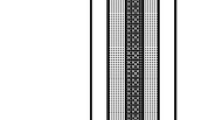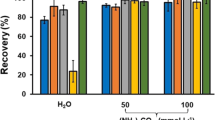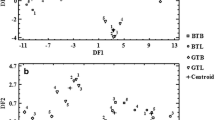Abstract
A method has been developed enabling direct analysis (i.e. after dilution only) of beer, instant coffee, milk, and milk powder by ICP–AES. Analysis of the beverages after dilution with a low concentration of HNO3 was used for accurate determination of essential minor and trace elements (Ca, Mg, K, P, S, and Zn). Selenium, introduced as the hydride, was determined simultaneously with the other non-hydride-forming elements using the commercial multi-mode sample-introduction system (MSIS). To obtain accurate results, however, some simple pre-treatment was needed. Analysis was also performed after microwave-assisted decomposition of the samples. Three different modes of sample-preparation, i.e. dilution only, partial decomposition (aqua regia treatment), and complete decomposition were compared. The results obtained by use of the three different sample-preparation methods were in very good agreement. Results from analysis of certified reference material (SRM 1459 non-fat milk powder) also verified the accuracy of the methods. The limit of detection obtained for Se using dual-mode sample introduction was 0.5 ng mL−1, which corresponds to approximately 2 ng g−1 in beer and approximately 4 ng g−1 in coffee and milk when using the recommended procedure.



Similar content being viewed by others
References
Dolan SP, Capar SG (2002) J Food Comp Analysis 15:593–615
Alcazar A, Pablos F, Martin MJ, Gonzalez AG (2002) Talanta 57:45–52
Bellido-Milla D, Onate-Jaen A, Palacios-Santander JM, Palacios-Tejero D, Hernandez-Artiga MP (2004) Microchim Acta 144:183–190
Wuilloud R, Marchevsky E, Olsina R, Martinez L (2001) J Anal Chem 56:77–80
Santos EJd, Oliveira Ed (2001) J Food Comp Analysis 14:523–531
Anderson KA, Smith BW (2002) J Agric Food Chem 50:2068–2075
Krejcova A, Cernohorsky T (2003) Food Chem 82:303–308
Riberio AS, Moretto AL, Arruda MAZ, Cadore S (2003) Microchim Acta 141:149–155
Nobrega JA, Gelinas Y, Krushevska A, Barnes RM (1997) J Anal At Spectrom 12:1243–1246
Wit MD, Blust R (1998) J Anal At Spectrom 13:515–520
Sroor A, El-Dine NW, El-Shershaby A, Abdel-Haleem AS (2003) J Environ Sci 15:570–576
McKinstry PJ, Indyk HE, Kim ND (1999) Food Chem 65:245–252
Murcia MA, Vera A, Martinez-Tome M, Munoz A, Hernandez-Cordoba M, Ortiz-Gonzalez R (1999) Lebensm-Wiss Technol 32:175–179
Coni E, Stacchini A, Caroli S, Falconieri P (1990) J Anal At Spectrom 5:581–586
Santos EJd, Oliveira Ed (2001) Brazil Arch Biol Technol 44:233–238
Carrion N, Murillo M, Montiel E, Diaz D (2003) Spectrochim Acta 58B:1375–1389
McLaughlin RLJ, Brindle ID (2002) J Anal At Spectrom 17:1540–1548
Rojas I, Murillo M, Carrion N, Chirinos J (2003) Anal Bioanal Chem 376:110–117
Pohl P, Zyrnicki W (2000) Chem Anal (Warsaw) 45:699–708
Svendsen R, Lund W (2000) Analyst 125:1933–1937
Wibetoe G, Takuwa DT, Lund W, Sawula G (1999) Fresenius J Anal Chem 363:46–54
Goodall P, Foulkes ME, Ebdon L (1993) Spectrochim Acta 48B:1563–1577
Ebdon L, Foulkes M, Sutton K (1997) J Anal At Spectrom 12:213–229
Uggerlud H, Lund W (1995) J Anal At Spectrom 10:405–408
Martinez LD, Saidman E, Marchevsky E, Olsina R (1997) J Anal At Spectrom 12:487–490
Stripeikis J, Tudino M, Troccoli O, Wuilloud R, Olsina R, Martinez L (2001) Spectrochim Acta 56B:93–100
Brindle ID, Lugowska E (1997) Spectrochim Acta 52B:163–176
Pohl P (2004) Trends Anal Chem 23:87–101
Author information
Authors and Affiliations
Corresponding author
Rights and permissions
About this article
Cite this article
Asfaw, A., Wibetoe, G. Simultaneous determination of hydride (Se) and non-hydride-forming (Ca, Mg, K, P, S and Zn) elements in various beverages (beer, coffee, and milk), with minimum sample preparation, by ICP–AES and use of a dual-mode sample-introduction system. Anal Bioanal Chem 382, 173–179 (2005). https://doi.org/10.1007/s00216-005-3188-2
Received:
Revised:
Accepted:
Published:
Issue Date:
DOI: https://doi.org/10.1007/s00216-005-3188-2




